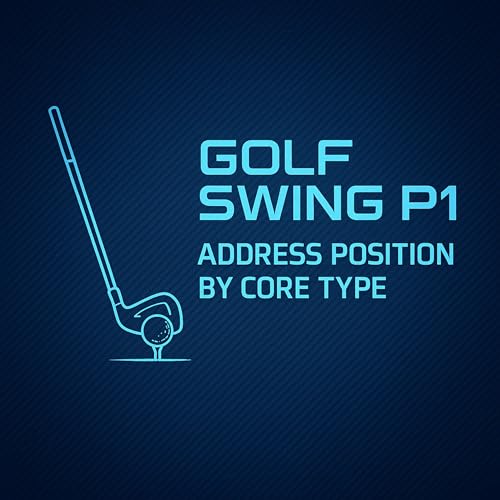
#376 Golf Swing P1: Address Position by Core Type
カートのアイテムが多すぎます
カートに追加できませんでした。
ウィッシュリストに追加できませんでした。
ほしい物リストの削除に失敗しました。
ポッドキャストのフォローに失敗しました
ポッドキャストのフォロー解除に失敗しました
-
ナレーター:
-
著者:
このコンテンツについて
The address position—P1—is where every great swing begins. It’s the static foundation from which motion, balance, and power emerge. A correct P1 ensures the body and club are synced before the backswing starts. Within the BioSwing Dynamics model, golfers are classified as Upper Core, Middle Core, or Lower Core players—each requiring a distinct setup to match natural biomechanics.
Upper Core Golfer – Vertical Motion
Upper Core players move more from the upper spine and shoulders. Their motion is upright and rotary, producing a steeper plane. They stand taller at address, with limited hip hinge and a chest that stays high. Hands are set higher—often in line with the shoulders—and the trail arm sits “on top” of the shaft. The club rests more upright, the ball slightly forward, and the stance is narrower with light knee flex. Balance often favors the balls of the feet, promoting freedom for an easy shoulder turn and vertical release.
Middle Core Golfer – Neutral Motion
The Middle Core player represents biomechanical balance. Motion starts from the body’s center, with the trail arm moving level to the torso. At P1, posture shows a moderate hip tilt and neutral spine, the right shoulder slightly lower. Hands rest near shoulder height, arms soft beside the ribcage. The grip and shaft lean are neutral, with the ball centered or just ahead. Feet are shoulder-width apart, weight evenly distributed, and knees naturally flexed. This neutral address creates symmetry—ideal for a rotational yet fluid swing.
Lower Core Golfer – Grounded Motion
Lower Core players use the ground as their engine. Power comes from hips and legs, creating a flatter, deeper swing plane. Their setup features a stronger hip hinge and more forward bend. The torso tilts closer to horizontal, with hands lower and arms hanging vertically. The trail elbow tucks into the body to support an inside path. The shaft lies flatter, the ball slightly back, and the stance wider with more knee flex. Weight favors the heels, giving a stable base for heavy lower-body engagement and a powerful rotary motion.
Matching Core and Balance
There is no single perfect weight distribution—it’s defined by body type. Middle Core golfers balance evenly across the feet, maintaining centered control. Lower Core golfers ground pressure toward the heels, building stability for hip-driven motion. Upper Core golfers, more upright, feel balance toward the balls of the feet to promote an agile pivot.
Why Core Type Matters
Small address variations can trigger major swing changes. A deeper hip hinge lowers the hand path and flattens the plane; higher hands lift it and steepen attack. Aligning P1 with one’s dominant core ensures motion efficiency, consistent contact, and natural rhythm.
In essence, the setup is not “one swing fits all.” It’s an anatomical partnership—posture, stance, and hand height tuned to the golfer’s engine room, whether it lies in the shoulders, the center, or the hips. Perfect P1 means perfect potential.
- www.Golf247.eu


